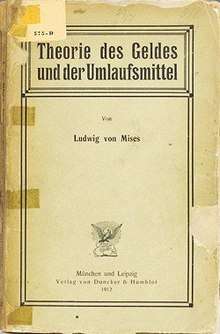The Theory of Money and Credit
The Theory of Money and Credit is a 1912 economics book written by Ludwig von Mises, originally published in German as Theorie des Geldes und der Umlaufsmittel. In it Mises expounds on his theory of the origins of money through his regression theorem, which is based on logical argumentation. It is one of the foundational works of the Misean branch of the Austrian School of economic thought.

Commodity money exists today. Mises looks at the origin, nature and value of money, and its effect on determining monetary policy. It does not concern all adaptations of money. He uses the so-called regression theorem, a statement backed by a step by step, logical reasoning. Mises explains why money is demanded in its own right. According to Mises, money has historically come about after there has been a demand for the money commodity in a barter economy.
Applications
Along with Carl Menger's Principles of Economics, and Eugen von Böhm-Bawerk's Capital and Interest, the book is one of the foundational works of the Austrian School.
Publication history
- 1912: Vienna: Theorie des Geldes und der Umlaufsmittel.[1]
- 1924: 2nd edition in German.
- 1934: London: Jonathan Cape Ltd. First translation (by Harold E. Batson) into English. The German word Umlaufsmittel literally translates as "means of circulation" and was translated into the text of the English version as "fiduciary media". However, the publisher thought the unusual terminology would irritate readers and substituted "money and credit" in the title, thereby losing the specific distinction Mises had made in selecting his original term.[2]
- 1953: New Haven, Conn.: Yale University Press. Part Four was added by Mises to this English language edition
- 1971: Irvington-on-Hudson, N.Y.: Foundation for Economic Education.
- 1978: Irvington-on-Hudson, N.Y.: Foundation for Economic Education.
- 1981: Indianapolis,. Ind. Liberty Fund. ISBN 0-913966-70-3. 541 pages. Hardcover. (Softcover ISBN 0-913966-71-1).
- 2009: Auburn, Al. Ludwig von Mises Institute. Hardcover
Criticism
According to Michael Hendricks, "the regression theorem does a good job of explaining the creation of money, however it does not necessarily apply to all forms of money."[3]
References
- 1914 review by J.M. Keynes.
- Hülsmann, Jörg Guido, 2007. Mises: The Last Knight of Liberalism. p. 217, note 7.
- Michael Hendricks (6 June 2013). "Reconciling the Regression Theorem with Bitcoin". Seth King. Retrieved 12 December 2014.
External links
- The Theory of Money and Credit, 1953 edition:
- The Theory of Money and Credit, 1981 edition:
- Foreword to the 1981 Edition by Murray Rothbard